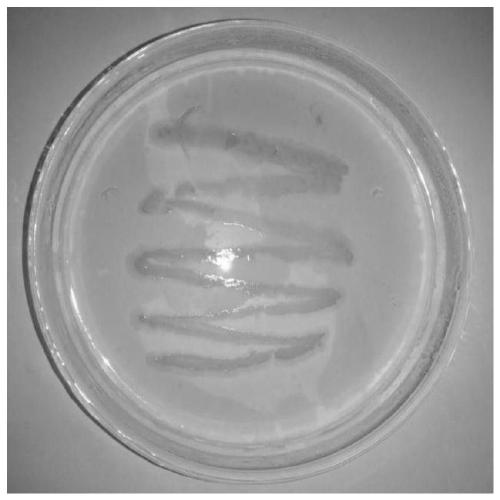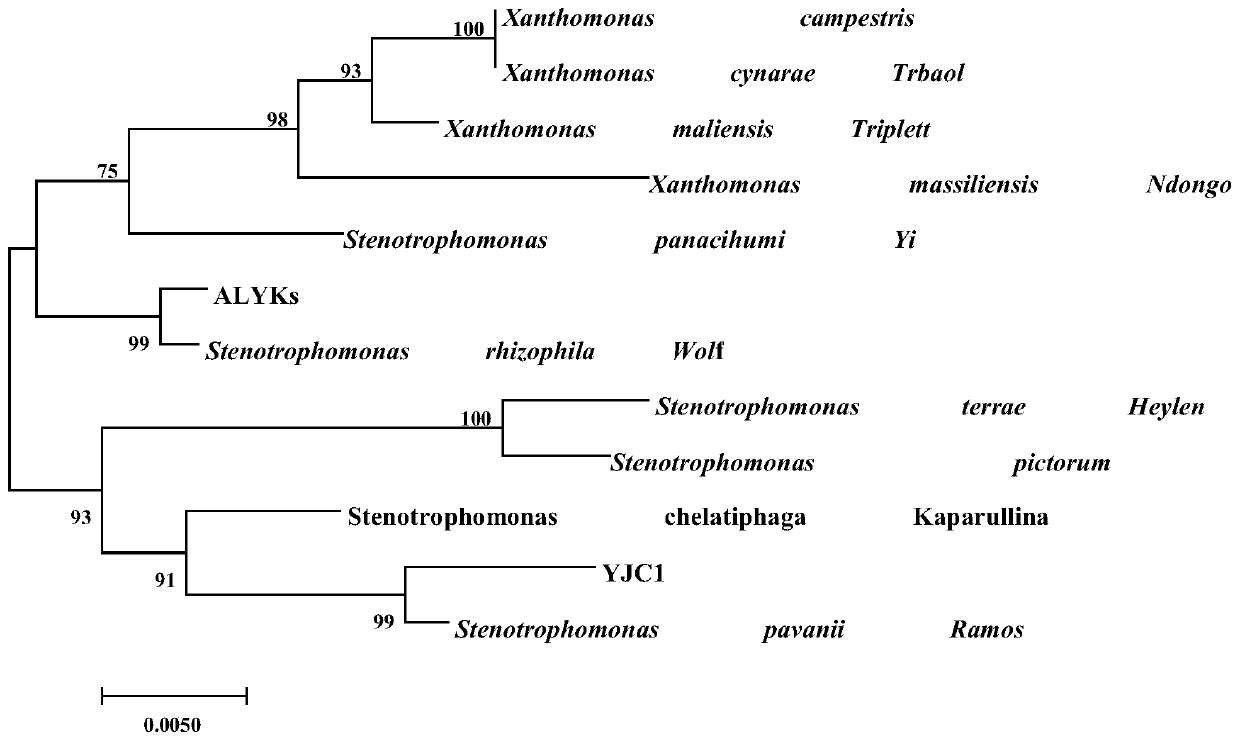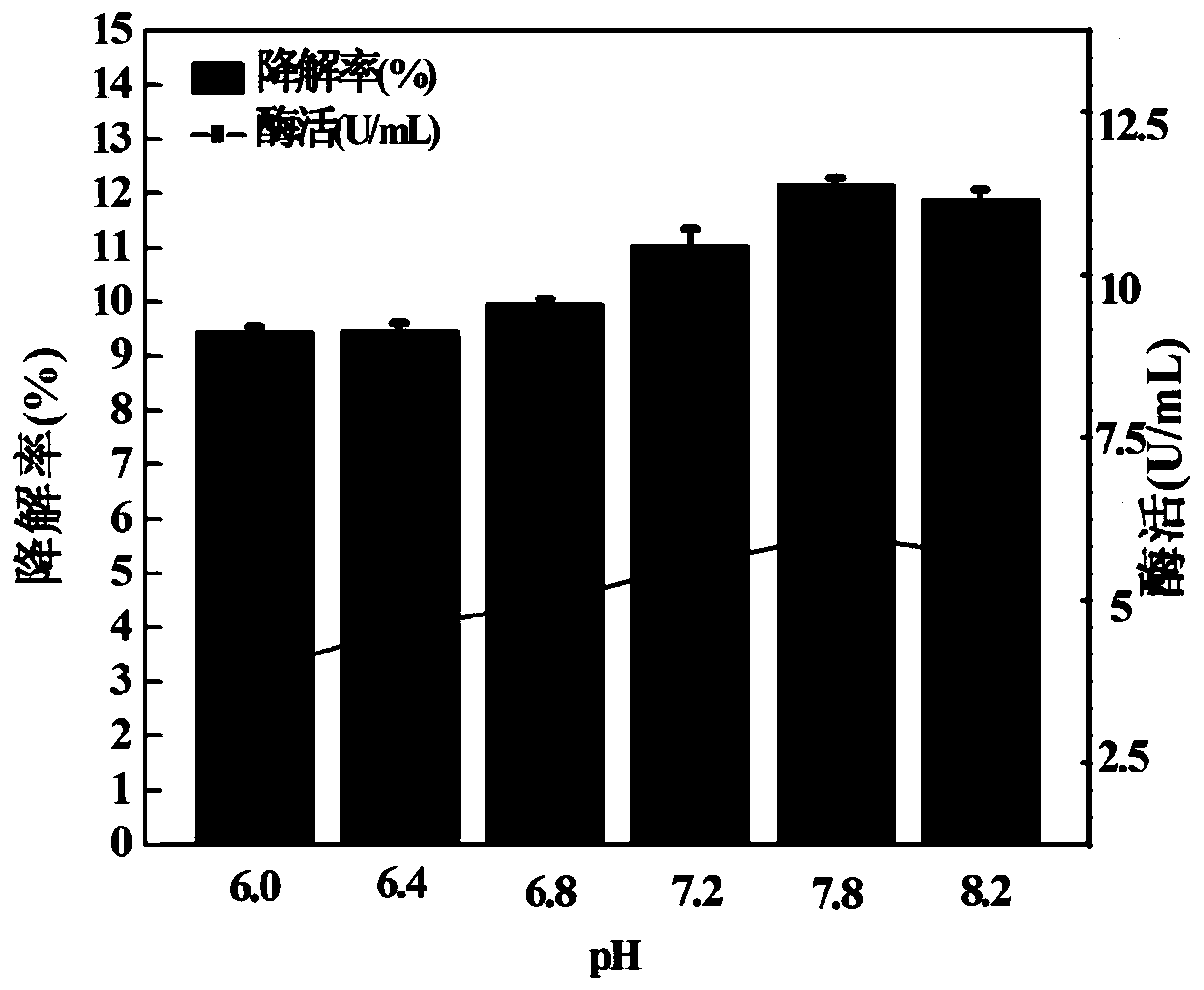Stenotrophomonas for efficiently degrading poly(butylene adipate-co-terephthalate) and application thereof
A technology of polybutylene terephthalate and adipate, which is applied in the direction of bacteria, hydrolase, and microorganism-based methods, can solve the problems of small number of microorganisms, slow degradation, and low degradation rate, and achieve excellent Degradation effect, strong adaptability, wide distribution effect
- Summary
- Abstract
- Description
- Claims
- Application Information
AI Technical Summary
Problems solved by technology
Method used
Image
Examples
Embodiment 1
[0034] Example 1 Isolation and identification of strains
[0035] 1. Plate separation and screening of PBAT degrading bacteria
[0036] Collect the soil of a farmland covered with PBAT mulch in Yanxia Town, Liquan County, Shaanxi Province, weigh 10g of soil into a 150mL Erlenmeyer flask of 90mL sterile water, and configure 10 -1 ~10 -6 A series of soil bacterial suspensions with a concentration gradient were inoculated into the inorganic salt medium with PBAT as the sole carbon source. After culturing in a constant temperature incubator at 37°C for 3 days, observe the growth of microorganisms on the medium and pick a single colony. Continuously inoculate it in the inorganic salt medium with PBAT as the sole carbon source for separation and purification until a strain of bacteria is isolated, and then observe its colony morphology, such as figure 1 As shown, the colony is orange-red, the edges are flat, and the surface is smooth.
[0037] 2. Identification of strains
[0038] The strai...
Embodiment 2
[0040] Example 2 Identification of lipase-producing ability of strains
[0041] This oligotrophomonas bacteria was inoculated on a grease medium and cultured at 37°C for 3 days. Observed that there are obvious red hydrolysis circles under the colony, it can be seen that the bacteria can produce lipase.
Embodiment 3
[0042] Example 3 Degradation experiment of strains on PBAT membrane and lipase production experiment.
[0043] 1. Preparation of PBAT film
[0044] Choose 5g of PBAT film with a molecular weight of 100,000, dissolve it in 95mL of analytically pure chloroform, stir it thoroughly and wait for it to dissolve, pour it into a mold, wait for the chloroform to volatilize, prepare a PBAT film, and cut it into 1 *1cm 2 The small pieces are used for the strain degradation PBAT membrane experiment.
[0045] 2. Medium preparation
[0046] On the basis of the inorganic salt medium with PBAT as the sole carbon source, 3% butanediol and other external carbon sources are added as the co-metabolism growth substrate of this bacteria.
[0047] 3. Preparation of seed liquid
[0048] The purified strain was inoculated into 100 mL of LB medium and cultured for 12 hours at 37°C and a shaker speed of 130r / min to obtain OD 600 The bacterial liquid with 1.0 was used as the seed liquid.
[0049] 4. Degradation exp...
PUM
 Login to View More
Login to View More Abstract
Description
Claims
Application Information
 Login to View More
Login to View More - R&D
- Intellectual Property
- Life Sciences
- Materials
- Tech Scout
- Unparalleled Data Quality
- Higher Quality Content
- 60% Fewer Hallucinations
Browse by: Latest US Patents, China's latest patents, Technical Efficacy Thesaurus, Application Domain, Technology Topic, Popular Technical Reports.
© 2025 PatSnap. All rights reserved.Legal|Privacy policy|Modern Slavery Act Transparency Statement|Sitemap|About US| Contact US: help@patsnap.com



